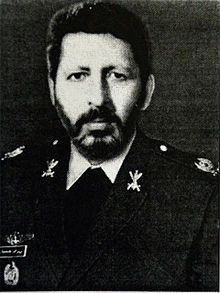Bahram Hooshyar
Bahram Hooshyar | |
|---|---|
 General Bahram Hooshyar | |
| Nickname(s) | General Hooshyar |
| Born | 1938 Tehran, Imperial State of Iran |
| Died | 1991 Tehran, Iran |
| Place of burial | |
| Allegiance | Islamic Republic of Iran |
| Service | |
| Years of service | 1964–1991 |
| Rank | |
| Commands | Golden Crown aerobatic jet team Special Operations Command South Air Force operations |
| Battles / wars | Iran–Iraq War |
| Awards | Air Force Distinguished Conquest Medal |
| Other work | Pilot of F-86 Sabre, F-4, F-5 |
Bahram Hooshyar (Persian: بهرام هشیار) (1938–1991) was an Iranian commander in the Islamic Republic of Iran Air Force (IRIAF) and an important strategist in the Iran–Iraq War.[1]
Operations
Attack on H3
General Hooshyar had a key role along with Major General Javad Fakouri in the Attack on H3 (Attack on Al-Waleed).
Operation Samen-ol-A'emeh
He also was involved in the planning of Operation Samen-ol-A'emeh, and also was an innovator of Iran's plan for launching missiles in battle.
Innovations
He for the first time established and started Khyber missile site (Foley Islamabad) along with some armored divisions operating in Qazvin.
Death
He died in Tehran in 1991 after a long battle with cancer. Like many soldiers serving in the Iran-Iraq War, he was diagnosed with leukemia. His sculpture at the Museum of the Air Force is on display as one of Iran's symbols of the Iran–Iraq War.
References
- ^ "Name of IRIAF commanders". Archived from the original on 2012-12-16. Retrieved 2012-09-05.
